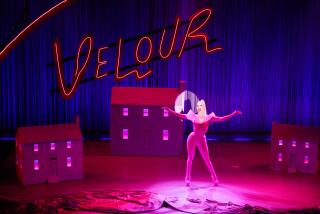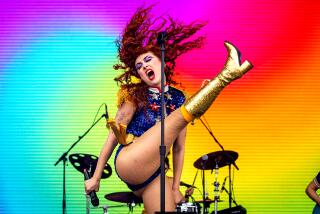Dance Music’s RuPaul: Poised for ‘World Domination’ : Pop music: The singer is the first transvestite to enter dance music’s top ranks since Sylvester in the late ‘70s, thanks to his lively hit ‘Supermodel.’
- Share via
“I moved to New York from Atlanta with a pair of high heels and a dream . . . and look at the bitch now.”
What the dance-music world is looking at is a bouffant vision in diamonds and chiffon named RuPaul, who stands seven feet tall when you include the stiletto heels and platinum wig. RuPaul is the first transvestite to enter dance music’s top ranks since Sylvester in the late ‘70s, thanks to his lively dance-chart hit “Supermodel.”
RuPaul, 27, says his recent album deal with Tommy Boy Records and the colorful, campy “Supermodel” video have him poised for nothing short of “world domination.”
“We’re entering the new era of glamour, and actually, I’m heralding it,” he said during a phone interview from New York this week. “Glamour is a response to the bleak ‘80s and a response to the whole Reagan-Bush era. That’s why there’s a sexy Democrat in the White House, and we’re returning to what’s fun and loving and . . . beautiful and full of color.
“Glamour is a celebration of life. But mainly, it’s really lots of fun.”
RuPaul, who will be performing at Studio One in West Hollywood tonight and Saturday, has picked up where Boy George left off by fusing gender-bending images with pop sensibilities.
In the “Supermodel” video, he sashays about in skimpy negligees and feather boas while belting the lyrics, “you better work.” Poking fun at obsessive image consciousness, he ends with a darkly humorous impression of Norma Desmond, Gloria Swanson’s deranged character from “Sunset Boulevard.”
“It’s a feel-good record, “ says RuPaul, who grew up in San Diego and whose last name is Charles. “It’s something you put on before you go out into the world.”
Citing Diana Ross and Aunt Esther (LaWanda Page from “Sanford and Son”) as influences, RuPaul sees drag queens as modern-day shamans: “They tell society what’s beautiful and what life is all about.”
Drag also has no gender restrictions, he says. “Drag is anything that you put on your body after you’re naked. Everybody has a role they play or a way they see themselves, and they dress accordingly.”
The drag balls celebrated in the acclaimed 1991 documentary “Paris Is Burning” represent a culture that gives strength to people who need to be adored, says RuPaul.
“These people, who have a very low standing in society, have built a world where they can feel loved and respected,” he says. “Everybody wants to be loved. Everybody wants to be respected. Everybody wants to feel like they belong somewhere.”
RuPaul, who began cross-dressing during the burgeoning punk movement of the late ‘70s, moved from San Diego to Atlanta at age 15 and continued to refine his act at the drag clubs that sprang up there in the mid-’80s.
“I went to the Northside School of Performing Arts with all these other wild creative kids, and it was so wonderful to be around creative people who were considered weird by other people, too.
“I’ve always been inspired by people who made it through adversity to the other side against all odds. That’s what appeals to me. Like a Diana Ross, or an Oprah Winfrey or a Whoopi Goldberg, who I adore, because who would have thought Whoopi would’ve been a big star 10 years ago? Nobody. Look at her now.”
He adds mischievously, “I can’t wait till I’m in L.A. doing ‘Sister Act III’ starring me. . . . Can’t you just see it?”
More to Read
The biggest entertainment stories
Get our big stories about Hollywood, film, television, music, arts, culture and more right in your inbox as soon as they publish.
You may occasionally receive promotional content from the Los Angeles Times.










